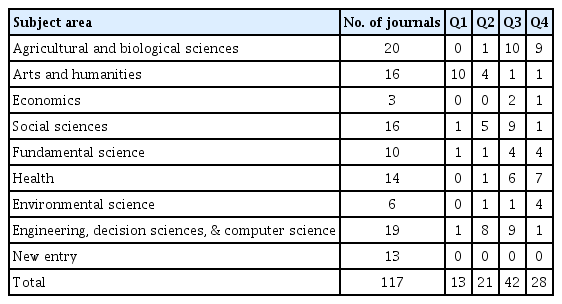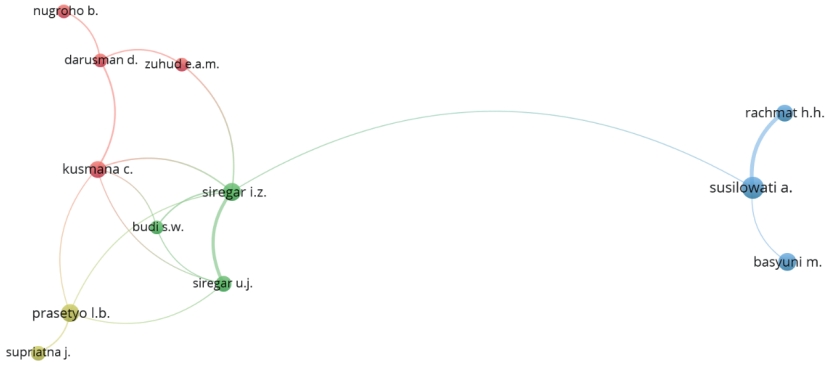Performance of Indonesian Scopus journals in the area of agricultural and biological sciences
Article information
Introduction
Background
In Indonesia, 1,264 publishers operate 7,410 scholarly journals accredited by the government, reflecting an increase of 23.71% from the previous data of 5,990 accredited scholarly journals [1]. Those journals are distributed as follows: 305 nationally reputable journals (4.12%) with an S6 accreditation, 2,099 journals (28.33%) with an S5 accreditation, 2,541 (34.29%) with an S4 accreditation, 1,369 (18.48%) with an S3 accreditation, 976 (13.17%) with an S2 accreditation, and 120 (1.62%) with an S1 accreditation (S1 indicates the highest level of accreditation for accredited journals in Indonesia).
The journals indexed in the Scopus database are generally in the S1 category. Although there are many scholarly journals in Indonesia, the number of international journals is still not enough relative to the total number. It is usually said that Scopus, Science Citation Index Expanded, Social Sciences Citation Index, and Arts and Humanities Citation Index journals are international journals. There may be enough room for science journals in Indonesia to be promoted to international journals. The Indonesian government has supported journal publication through the journal accreditation system [1], and there is a need for academic societies and institutes to upgrade their journals. To promote journals, the topic of articles is a major concern. Articles on recently emerging topics or those frequently dealt with are beneficial to journals to be read and cited by other researchers. Therefore, it is essential to find the major topics and other bibliographic trends in a specific research area. A bibliometric analysis is a good tool to answer these questions. In this essay, journals in the agricultural and biological sciences were analyzed because the number of journals in this area was the highest among all research areas of Indonesian journals listed in Scopus.
Objectives
This essay aimed to reveal the bibliometric analysis of Scopus journals in the area of agricultural and biological sciences in Indonesia until the end of June 2022. The analysis included highly cited articles, co-authorship networks, keyword co-occurrence networks, and citation networks. The results can provide insights into the research trends and network of Indonesian researchers and co-researchers in the agricultural and biological sciences so that more intensive international collaboration can be pursued.
Methods
Ethics statement
This was not a human-subject study; therefore, neither Institutional Review Board approval nor informed consent was needed.
Study design and setting
This study conducted a bibliometric analysis of data from Scopus [2]. First, Scopus journals published in Indonesia were classified according to the subject area. Second, data were retrieved from the Scopus database from July 5 to 10, 2022. All data at the time of the search were collected. The search terms were 20 journals in the “journal” field (Suppl. 1). The retrieved data from Scopus included metadata of 20 journals in the subject area of agricultural and biologicals ciences (Dataset 1). Third, a bibliometric analysis of 20 target journals w as done to visualize the highly cited articles, the co-authorship network, keyword co-occurrence network, and citation network with VoSViewer ver. 1.6.16 (Centre for Science and Technology Studies, Leiden University; https://www.vosviewer.com).
Statistical methods
Descriptive statistics were presented.
Distribution of Indonesian Journals Indexed in the Scopus Database According to the Subject Area
In July 2022, there were 117 Indonesian journals indexed in Scopus. These journals are grouped into eight fields of science, with one group of “new entry” (Table 1).

Distribution of Scopus journals from Indonesia according to subject area and SJR quartile (Q) ranking
Table 1 shows that the Scopus journals published in Indonesia were mostly included in Q3 (35.89%), and journals with the subject area of arts and humanities had the highest number included in Q1. This presentation indicates that the field of arts and humanities has gained interest and popularity, as well as refe rences from authors. However, when analyzing the distribution of journals published in Indonesia by subject area, the fields of agricultural and biological sciences, engineering, decision sciences, and computer science contributed the most publications, reaching 20 journals for agricultural and biological sciences, and 19 journals for engineering, decision sciences, and computer science.
The journals included in the Scopus database did not experience a significant increase for a long time after the launch of Scopus. It was only from 2015 to 2022 that international journals published in Indonesia started to be indexed by Scopus. Even in 2020, there were only 19 Indonesian journals included in the Scopus database.
Bibliometric Analysis of the 20 Scopus Journals Published in Indonesia in the Subject Area of Agricultural and Biological Sciences
Highly cited articles
In this subject area, there are 20 journals occupying Q3 and Q4. Kukila, which is currently published by the Indonesian Ornithologists Union, became the first journal included in the Scopus database in 1996. However, Biodiversitas, published by the Society for Indonesian Biodiversity and co-publisher by the Department of Biology, Faculty of Mathematics and Natural Sciences, Universitas Sebelas Maret Surakarta, was acknowledged to be the most productive journal, as it published 3,069 articles since 2014 and obtained 8,292 citations or 2.7 average cites per article. The average number of cites per article is obtained from the total citations divided by the total papers. The 10 top-ranking highly cited articles from these 20 journals are listed in Table 2.
Co-authorship network
Fig. 1 depicts the 121 countries from which authors have contributed to 20 Scopus journals in Indonesia. When a minimum number of 14 documents from a country was applied, 31 countries were identified. Japan (189 documents, with a total of 583 citations and a total link strength of 197), Malaysia (214 documents, with 594 total citations and a total link strength of 124), and Australia (122 documents, with a total citation of 326 and a total link strength of 137) had the strongest collaborative relations with Indonesia compared to other countries. This presentation is signified by the established links between Indonesia and Japan, Indonesia and Malaysia, and Indonesia and Australia.

Network of Indonesian authors with authors from other countries in the field of agricultural and biological sciences from Scopus journals published in Indonesia.
When analyzing authors’ contributions, 14,361 authors have published in Indonesian Scopus journals focusing on agricultural and biological sciences. Fig. 2 shows the network of authors who contributed to this area, which formed four clusters. Fifty-eight authors had at least 15 papers. Partasasmita R (Universitas Padjadjaran, Bandung, Indonesia) had the most publications, with 57 publications, a total of 215 citations, and a total link strength of 67. Followed by Iskandar J (Universitas Padjadjaran) with 53 publications, 284 citations, and a total link strength of 75; and Susilowati A (Universitas Sumatera Utara, Medan, Indonesia) with 40 publications, 170 total citations, and a total link strength of 20.
Keyword co-occurrence network
Four topics were dealt with most frequently (Fig. 3): diversity, conservation, genetic diversity, and biodiversity. These four aforementioned topics indicate that Indonesia’s richness and biodiversity provide sources of research for publication.
Citation network
The journal with the most references from other journals was Biodiversitas, published by the Department of Biology, Sebelas Maret University Surakarta (Fig. 4). The visualization results are in line with the data in Suppl. 1, emphasizing that Biodiversit as the journal that published the most articles and was cited the most.
Conclusion
Partasasmita R was the author with the most publications. Authors in Japan, Malaysia, and Australia contributed the most to the network of Indonesian authors. In addition, diversity, conservation, genetic diversity, and biodiversity were identified as the most widely investigated research topics in the agricultural and biological sciences. Those findings can serve as a model of bibliometric analysis for journals in other research areas.
Notes
Conflict of Interest
No potential conflict of interest relevant to this article was reported.
Funding
The authors received no financial support for this article.
Data Availability
Dataset file is available from the Harvard Dataverse at https://doi.org/10.7910/DVN/4BPXO9.
Dataset 1. Raw data retrieved from the Scopus database with a search for 20 Indonesian journals in the area of agricultural and biological sciences.
Supplementary Material
Supplementary file is available from the Harvard Dataverse at https://doi.org/10.7910/DVN/4BPXO9.
List of internationally reputable journals published in Indonesia in the field of a gricultural and biological sciences.




